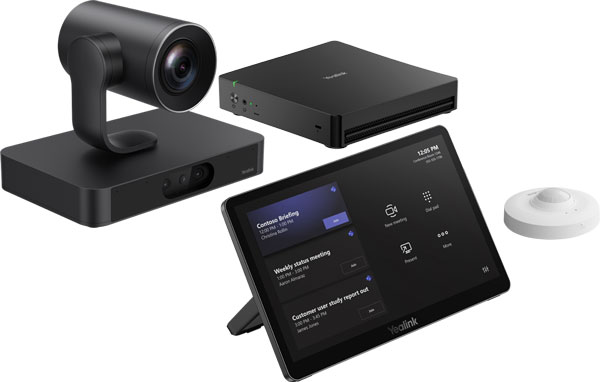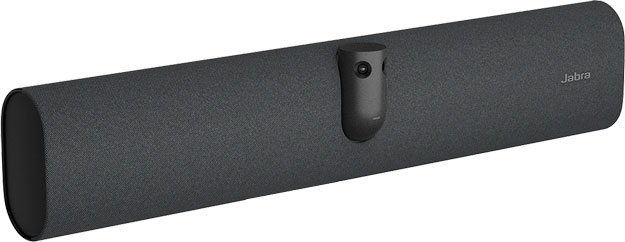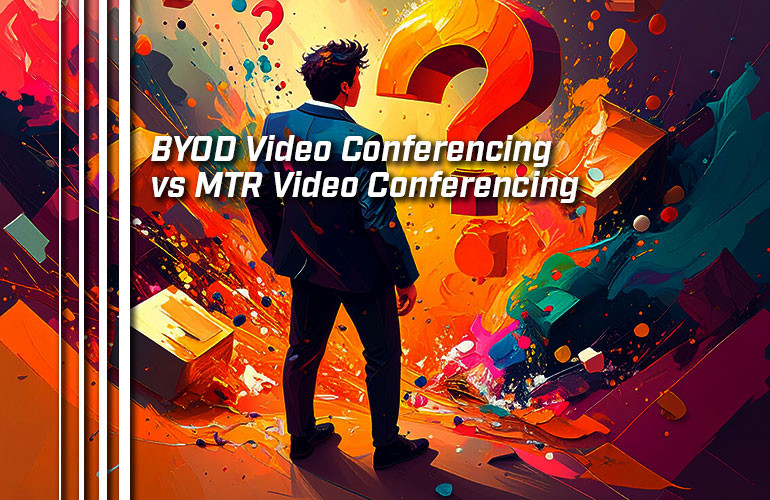Professional Microsoft Teams Video Conferencing demands professional equipment.
How do you meet that demand and set up your business for ultimate success?
There are two primary options for Microsoft Teams video conferencing: BYOD systems and MTR systems.
In this blog, we explain the difference between BYOD and MTR systems, when you should use a BYOD system vs when you should use an MTR system, and how you can turn one into the other.
Let’s get into it!

What Does MTR Mean for Video Conferencing?
MTR stands for Microsoft Teams Rooms. Why is that important?
Microsoft Teams is a cloud service for business communications. There are additional services that you can add to Teams.
Microsoft Teams Rooms is one of these add-on services. It enables “intelligent meeting spaces” (as they put it). More generically, you’d call it a group video conferencing or virtual meeting solution.
MTR systems are systems that work with Microsoft Teams Rooms. They are Certified for Microsoft Teams. What does that mean?
Microsoft has a certification program for devices to ensure compatibility with Teams.
As they explain in their “Overview of Teams certified devices” (external link) on the Microsoft Learn website: “This program tests the devices based on a set of rigorous specifications, covering aspects such as audio and video quality, user interface, device management, and security. Only devices that successfully pass all certification requirements, and associated testing receive the designation of Certified for Microsoft Teams [sic].”
MTR systems can consist of a whole range of devices, from cameras to touch consoles to interactive whiteboards to Pro AV speakers and microphones, and on and on.
Yealink, Poly, Jabra, and other manufacturers offer bundles of equipment that provide complete solutions for Microsoft Teams conference room. These bundles come with devices that suit a range of room sizes. Yealink releases kits under the name MVC Series. They’ve just released the fourth generation of MVC kits.
For example, Yealink MVC S40-C5U has devices chosen for optimal performance in small to medium rooms: a dual-eye video, large-screen touch console, and updated mini-PC. The Microsoft Teams Rooms app is already installed. The whole system is ready to go.
On the other hand, Yealink MVC S90-C5U works for extra-large rooms with two video conferencing cameras, a Pro AV processor, and more.
If you’d like to know more about the whole range Microsoft Teams video conferencing equipment, check out our clear, comprehensive Microsoft Teams Rooms Buyer’s Guide.
Now, let’s take a look at BYOD systems.

What Does BYOD Mean for Video Conferencing?
BYOD stands for Bring Your Own Device.
BYOD video conferencing systems are composed of devices that work with many platforms, rather than just one.
They rely on USB for connectivity. The U in USB stands for “universal,” which, when you think about it, is all BYOD means: a universal solution.
Typically, all you need to do is select the USB device as a peripheral within the communications platform’s settings, the same as you would with a webcam or USB headset.
Just like with MTR systems, there’s a full range of professional USB video conferencing devices to choose from.
For example, Poly Studio V52 is a USB video bar for medium rooms that supports 4K Ultra HD video, DirectorAI automatic framing and tracking technologies, and more.
There are many BYOD video conferencing solutions.

MTR Systems and BYOD Systems Compared
Why go with an MTR solution? Why go with a BYOD solution?
The advantages of MTR systems are everything that’s tested when the devices go through the Microsoft Teams certification program: guaranteed performance, native compatibility, enterprise-grade security, exceptional build quality, and so on.
When compared with BYOD systems, they streamline installation and management. You don’t need to worry about cobbling together devices and you get guaranteed professional performance.
We wanted to highlight simplified management.
With Yealink BYOD equipment, you might need to use software like Yealink RoomConnect to adjust equipment and control settings. While RoomConnect itself is excellent and easy to use, it’s likely that not everyone will have it installed on their laptop, which means specific people need to be present to adjust settings.
With an MTR system, on the other hand, anyone can adjust settings using the ever-present touch console as a controller and the ever-present mini-PC that runs the application.
Support staff also tend to prefer MTR systems because they’re less finicky. Getting everything to work together can be challenging.
BYOD systems might also not support the full range of features that Teams offers.
Because they’re USB devices, they might not be of the same professional quality, like using a webcam vs a video conferencing camera. They might not look as professional as having a unified MTR system in a conference room, too.
So, why would anyone go with BYOD?
The primary advantage of BYOD systems is they prevent service lock-in. If your business uses multiple platforms or plans to change platforms in the future, having BYOD infrastructure can be very essential.
Often, they’re also more versatile. If you don’t have a dedicated conference room, it can be easier to move USB devices from place to place.
If you decide to go with an MTR solution, you might be able to make into a BYOD system, so you might be able to use your Teams equipment with Zoom, Webex, RingCentral, or other platforms.
How? You can make some Yealink MTR systems into BYOD systems by using the Yealink MVC BYOD-Extender. This is a USB adapter for your MVC video conferencing devices.
That’s right: it makes MTR devices into universal USB devices.
Note that Yealink BYOD-Extender is not compatible with every MVC system. For up-to-date compatibility, see the “MVC BYOD-Extender” (external link) page on the Yealink Knowledge Base support site.

